LIFE IN THE DESERT
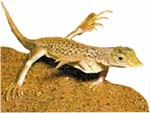  Extreme
heat that reaches up to 50-60oC (122-140oF)
in the daytime, freezing cold at night, drought that can last
for weeks even months, and very little amount of food. You
might think it impossible to live in such a place. These tough
places are deserts and, contrary to what you might think,
many creatures live in the desert. Below we mention some of
these creatures. Extreme
heat that reaches up to 50-60oC (122-140oF)
in the daytime, freezing cold at night, drought that can last
for weeks even months, and very little amount of food. You
might think it impossible to live in such a place. These tough
places are deserts and, contrary to what you might think,
many creatures live in the desert. Below we mention some of
these creatures.
One desert animal is the cream
coloured fox, which is the smallest of all fox species (on
the next page). The ears of this fox species are bigger than
those of others. These wide ears are very useful for the fox,
which lives in the sandy deserts of Africa and Arabia. For
example, the fox can easily determine its prey's location
thanks to its sensitive ears. Preventing excessive heating,
these ears also help the animal remain cool.
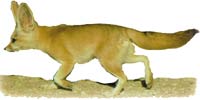  Another
creature that lives in the deserts is the shovel-snouted lizard
(below). To cool its tail and feet, this creature moves on
hot sands as if it were dancing. Supported by its tail, it
raises one of its front and one of its back legs transversely.
A few seconds later, it is the turn of the other two legs.
With its peculiarly shaped nose and body, the lizard moves
in the mounds of sand as if swimming. Its big feet enable
it to run fast on the sand without being hurt by the heat. Another
creature that lives in the deserts is the shovel-snouted lizard
(below). To cool its tail and feet, this creature moves on
hot sands as if it were dancing. Supported by its tail, it
raises one of its front and one of its back legs transversely.
A few seconds later, it is the turn of the other two legs.
With its peculiarly shaped nose and body, the lizard moves
in the mounds of sand as if swimming. Its big feet enable
it to run fast on the sand without being hurt by the heat.
The desert frogs that live in
Australia are like water tanks. A desert frog fills the pouches
in its body with water when it rains. Then it buries itself
in the sand and begins to wait for the next rain. Thanks to
the water they store in their pouches, desert frogs can survive
in the desert.
Have you noticed the common
characteristics of desert creatures, of which we have given
a few examples here? Their body structures are remarkably
designed for living in the desert and they have characteristics
quite distinct from other creatures. Also, these animals apparently
know very well how they should act for protection from the
desert heat and to cope with thirst. How could a frog or a
lizard have such knowledge? How could they possess the exact
body structure that they require?
Certainly animals could not
know these things by themselves. They could neither create
water tanks in their bodies nor generate big ears to protect
themselves from the heat. In order to survive in the desert,
these creatures must have had these characteristics since
they came into being. Otherwise, they would soon become extinct
from excessive heat, thirst or hunger. However, this does
not happen. Moreover, all desert creatures on earth have the
capacity to endure desert conditions. Each species has unique
characteristics that enable it to survive in the desert.
All these lead us to one truth.
The One Who created desert creatures together with the features
they have today is Allah. Allah has power to do whatever He
likes at any time He likes. In a verse of the Qur'an, Allah
informs us that everything is easy for Him:
The Originator
of the heavens and earth. When He decides on something, He
just says to it, "Be!" and it is. (Surat al-Baqara: 117)
THE SPECIAL COOLING SYSTEM
OF GAZELLES
 Air
conditioners protect us from cold in winter and from heat
in summer. Yet, humans are not the first to discover cooling
systems. Many creatures already have in their bodies cooling
systems that function like air conditioners. Air
conditioners protect us from cold in winter and from heat
in summer. Yet, humans are not the first to discover cooling
systems. Many creatures already have in their bodies cooling
systems that function like air conditioners.
We may give the fast running
gazelles of Africa as an example. Like many others, this animal,
too, has to run away from its enemies to survive because it
does not have any other defence mechanism. Yet, this fast
running increases its body heat excessively, which is very
dangerous for the gazelle because as the body heat increases,
so does the gazelle's brain heat. However, in order for the
gazelle to survive, its brain heat needs to be cooler than
that of the body. So you may wonder how it is that gazelles
don't die.
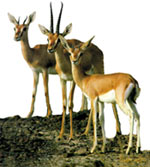 The
answer to this question leads us to the fact of creation. The
answer to this question leads us to the fact of creation.
The brain of a gazelle is cooled
by a special cooling system located on the right side of its
head. Gazelles and other fast-running animals have breathing
canals. Hundreds of small blood veins spread in the large
blood accumulations behind these canals. The air the gazelle
inhales cools this area and hence the blood that passes through
these small blood veins. These small veins then unite in a
single blood vessel that conveys blood to the brain. Thanks
to this system, the gazelle is not affected by the sharp increase
in its body heat while running.
You must have already concluded
that such a perfect system could not have come into existence
spontaneously over time. That is because the lack of this
system, which is required for cooling the brain, would mean
the death of the gazelle during its very first run.
As seen in the cooling system
of gazelles, there is perfect design in living creatures.
In other words, the body structure and the organs of a living
thing cannot possibly come into existence over time as claimed
by evolutionists.
All creatures have body structures
consisting of systems that would not work even if one of the
components were missing, such as the cooling system of gazelles.
This proves that living creatures did not come into existence
over time as a result of coincidences as evolutionists claim,
but Allah created them. It is crystal clear to those who can
take heed and use their intellect. Allah commands in a verse:
..."The Lord of
the East and the West and everything between them if you used
your intellect." (Surat ash-Shu'ara': 28)
THE STRENGTH OF WOODPECKERS
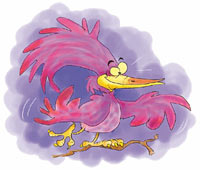 Woodpeckers
make their nests and food stores by pecking holes in trees.
The speed at which a woodpecker bores into a tree with its
bill is approximately 40 km/hour (25 miles/hour). This, in
fact, is an extraordinary speed that could have damaged the
woodpecker. However, there is a special locking system in
the bird's beak so that it does not sustain injury. If this
special system did not exist, the woodpecker's beak would
crack in two because of the high speed. Besides, if the impact
of the stroke went directly to the brain, then the bird would
lose consciousness. Yet, such a thing never happens since
Allah created the bird together with what it needs. The woodpecker's
brain is placed at the same level as its beak. Muscles on
the lower part of the beak act like "shock absorbers" and
reduce the shock that occurs while boring into the tree. Woodpeckers
make their nests and food stores by pecking holes in trees.
The speed at which a woodpecker bores into a tree with its
bill is approximately 40 km/hour (25 miles/hour). This, in
fact, is an extraordinary speed that could have damaged the
woodpecker. However, there is a special locking system in
the bird's beak so that it does not sustain injury. If this
special system did not exist, the woodpecker's beak would
crack in two because of the high speed. Besides, if the impact
of the stroke went directly to the brain, then the bird would
lose consciousness. Yet, such a thing never happens since
Allah created the bird together with what it needs. The woodpecker's
brain is placed at the same level as its beak. Muscles on
the lower part of the beak act like "shock absorbers" and
reduce the shock that occurs while boring into the tree.
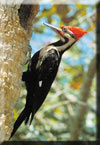 What
we have mentioned so far are only a few of the general characteristics
of woodpeckers. Apart from those mentioned, every woodpecker
species has many characteristics peculiar to itself. Now let's
consider a kind of woodpecker that hides acorns in trees. What
we have mentioned so far are only a few of the general characteristics
of woodpeckers. Apart from those mentioned, every woodpecker
species has many characteristics peculiar to itself. Now let's
consider a kind of woodpecker that hides acorns in trees.
 Throughout
summer, the acorn woodpecker bores "holes" in a dead tree
trunk because at the end of the summer it will fill these
holes with acorns, on which it will feed during winter. Acting
like a hammer, it drives one acorn in each hole. This takes
a great deal of the woodpecker's time because it tries to
find the acorn that fits exactly into the hole it has bored.
If the hole is big and the acorn is small, then the loose
acorn will easily be taken by other birds. If the hole is
smaller than the acorn, then the acorn will be damaged while
it is being forced into the hole. Therefore, it takes some
time for the woodpecker to place acorns by trial and error. Throughout
summer, the acorn woodpecker bores "holes" in a dead tree
trunk because at the end of the summer it will fill these
holes with acorns, on which it will feed during winter. Acting
like a hammer, it drives one acorn in each hole. This takes
a great deal of the woodpecker's time because it tries to
find the acorn that fits exactly into the hole it has bored.
If the hole is big and the acorn is small, then the loose
acorn will easily be taken by other birds. If the hole is
smaller than the acorn, then the acorn will be damaged while
it is being forced into the hole. Therefore, it takes some
time for the woodpecker to place acorns by trial and error.
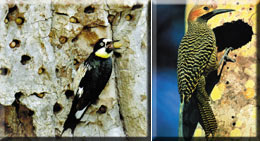 A woodpecker that stores acorns
in the holes in the trunk of an oak (top left) and another
woodpecker species (right).
A woodpecker that stores acorns
in the holes in the trunk of an oak (top left) and another
woodpecker species (right). |
Yet there is even more that
a woodpecker needs to do. As acorns dry over time they become
smaller. This means that the woodpecker should replace dry
acorns with fresh ones.
It should also be noted that
the woodpecker does not merely store 5 to 10 acorns; an acorn
woodpecker can stock approximately 50,000 acorns in a big
tree.
Reflecting upon these interesting
characteristics, we understand that there is a superior Power
Who teaches all these things to woodpeckers. This power is
Allah. Allah created the beaks of woodpeckers strong enough
to drill bark. It is Allah Who taught them everything they
do. There is no other god and creator besides Allah. Allah
informs us that He created everything:
That is Allah,
your Lord. There is no god but Him, the Creator of everything.
So worship Him. He is responsible for everything. (Surat al-An'am:
102)
CUTE SQUIRRELS WITH BIG
CHEEKS
  The
squirrel you see in the picture below is the ground squirrel,
also called the squirrel with cheek pouches. What distinguishes
this squirrel species from others is that it carries the food
that it does not consume right away in the pouches in its
cheeks. The squirrel stocks this food for future use. The
squirrel you see in the picture below is the ground squirrel,
also called the squirrel with cheek pouches. What distinguishes
this squirrel species from others is that it carries the food
that it does not consume right away in the pouches in its
cheeks. The squirrel stocks this food for future use.
These cheek pouchess are actually
loose folds of skin. The interior lining of these folds is
bare but not humid, therefore food can be stored in these
pouches for a long time without spoiling. These pouches extend
to the sides.
To fill these pouches, the squirrel
takes a walnut between its paws and cuts off the pointy parts
on both ends with its teeth. Then it puts the walnut in one
of the pouches and the next walnut in the other. Pouches are
filled in this way one after the other. The animal can place
four walnuts in each pouch. So, the face of the squirrel alters
so that we think it is interesting and cute.

|
